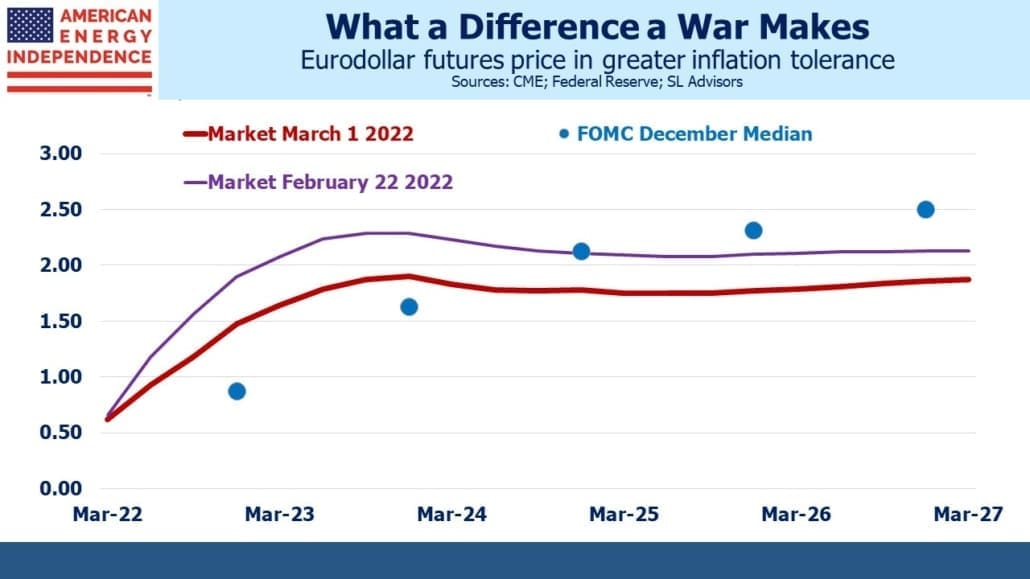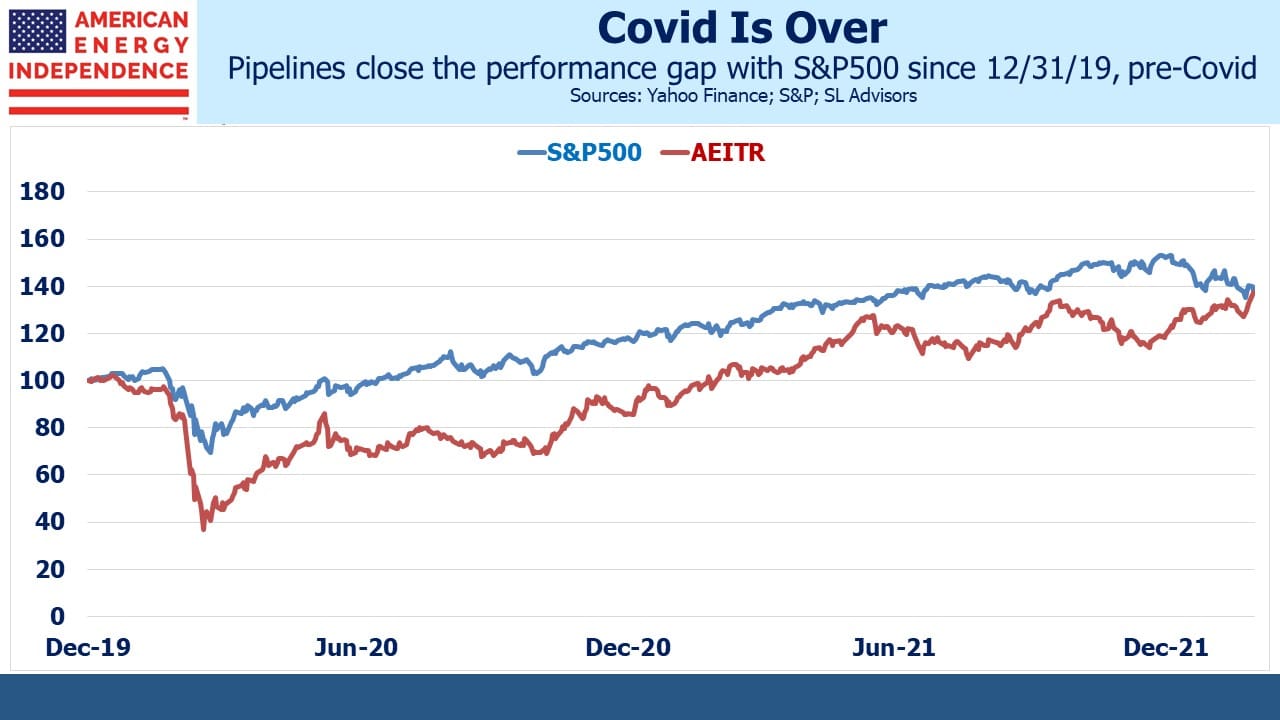Energy: Transition Or Security
Who can’t be moved by the pictures of women being trained to fire automatic weapons, and crates of Molotov cocktails being prepared in backyards. The Ukrainian people are drawing the world’s admiration and financial markets’ attention. There are numerous possible paths for the war to follow, and each one brings its own set of investment outcomes with risks. It’s hard to have high conviction on any assessment, because few of us have the background. But run through all the scenarios you can imagine, and every one of them includes Europe finding alternatives to Russian natural gas.
Sunday’s extraordinary meeting of Germany’s Bundestag was a watershed. For decades European nations have underspent on their defense needs – something Trump brought up regularly including in this meeting. Past presidents rarely did.
Now Europe will rearm, starting with Germany’s decision to spend an additional €100BN on defense. And they will build two import terminals for Liquified Natural Gas (LNG). Germany is especially exposed, since Russia provides over half their natural gas which itself constitutes over 30% of total energy consumption. Switzerland, Denmark and Italy all rely on Russia for over a third of their natural gas. Of the four, only Italy has LNG import capability. Landlocked Switzerland doesn’t have that option.
For an in-depth look at Europe’s natural gas options to prepare for next winter, read Preparing for the first winter without Russian gas.
Even if Putin was implausibly replaced with a non-despot, the shift in European energy security will roll on, because planning takes years and the prior policy has been discredited. Amid all the uncertainties of a war in Europe, their need for alternative LNG and the US’s ability to help provide that is a reliable outcome. Tellurian and NextDecade, two nascent LNG companies with contracts but not yet secure financing, have both rallied strongly on improved expectations that their projects will be completed.
What’s less clear is whether US energy policy will change. Europe’s energy security is suddenly a big concern. Chevron CEO Mike Wirth called for US policy to support investment in our domestic energy industry. It’s too early to tell whether it will become US policy to provide that security through increased oil and gas production. Probably not with a Democrat administration, although Senator Joe Manchin has called for the US to end imports of Russian oil, which is a start.
The west is edging towards placing sanctions on Russian oil and gas exports. It’s a good time to avoid any overly-confident forecasts unless they’re like US midstream where any outcome confirms its increased importance.
Today’s investors in pipelines own a call option on US energy policy shifting in response to Europe’s suddenly changed need. The sector isn’t yet priced for it, so US midstream energy infrastructure can only benefit and has no discernible downside from a policy reassessment.
What’s also changed is the inflation outlook, which must be higher in almost every scenario. Europe’s pivot on energy policy is bullish for prices. This will feed through to inflation. 2023 eurodollar futures yields have fallen by 0.40% two days, sharply reducing the expected path of short term interest rates. Higher energy prices will constrain growth while boosting inflation.
Given the Fed’s bias towards maximizing employment and greater tolerance for inflation risk, the market’s repricing makes sense. Elevated crude oil because of the energy transition or geopolitics seems the type of upward pressure to which the Fed would find little benefit in responding.
Here again, pipelines with their PPI-linked tariffs represent a good way for investors to construct portfolios with inflation protection. Ten year inflation as measured by TIPs and treasury notes has edged up 0.15% in the past week despite the drop in nominal yields.
The energy transition as pushed by climate extremists offers the antithesis of energy security, since it seeks reduced supply. Proponents of renewables like to argue that they create independence too – the utopian ideal of a countryside packed full of solar panels and windmills would seem to be free of imported fossil fuels from unreliable suppliers. But so far renewables remain insignificant, and the immediate problems are not going to be solved with solar and wind.
The physical security of renewables doesn’t receive much attention, but fragile solar panels are easily damaged by hard objects. If progressive policies had made it to Ukraine so that the country ran on solar, the Russians could have disabled their power supply with airdrops of ball bearings. The energy transition is colliding with energy security. As US consumers pay more to fill up at the pump, they’ll demand more oil not more windmills.
The American Energy Independence Index (AEITR) has been outperforming the S&P500 ever since its March 2020 Covid low. The reassessment of energy policy triggered by Russia’s invasion has given AEITR a further boost, so it’s now recouped all its relative underperformance since pre-Covid. Last week’s events make an investment in the sector even more compelling.
We have three funds that seek to profit from this environment:
Please see important Legal Disclosures.
Important Disclosures
The information provided is for informational purposes only and investors should determine for themselves whether a particular service, security or product is suitable for their investment needs. The information contained herein is not complete, may not be current, is subject to change, and is subject to, and qualified in its entirety by, the more complete disclosures, risk factors and other terms that are contained in the disclosure, prospectus, and offering. Certain information herein has been obtained from third party sources and, although believed to be reliable, has not been independently verified and its accuracy or completeness cannot be guaranteed. No representation is made with respect to the accuracy, completeness or timeliness of this information. Nothing provided on this site constitutes tax advice. Individuals should seek the advice of their own tax advisor for specific information regarding tax consequences of investments. Investments in securities entail risk and are not suitable for all investors. This site is not a recommendation nor an offer to sell (or solicitation of an offer to buy) securities in the United States or in any other jurisdiction.
References to indexes and benchmarks are hypothetical illustrations of aggregate returns and do not reflect the performance of any actual investment. Investors cannot invest in an index and do not reflect the deduction of the advisor’s fees or other trading expenses. There can be no assurance that current investments will be profitable. Actual realized returns will depend on, among other factors, the value of assets and market conditions at the time of disposition, any related transaction costs, and the timing of the purchase. Indexes and benchmarks may not directly correlate or only partially relate to portfolios managed by SL Advisors as they have different underlying investments and may use different strategies or have different objectives than portfolios managed by SL Advisors (e.g. The Alerian index is a group MLP securities in the oil and gas industries. Portfolios may not include the same investments that are included in the Alerian Index. The S & P Index does not directly relate to investment strategies managed by SL Advisers.)
This site may contain forward-looking statements relating to the objectives, opportunities, and the future performance of the U.S. market generally. Forward-looking statements may be identified by the use of such words as; “believe,” “expect,” “anticipate,” “should,” “planned,” “estimated,” “potential” and other similar terms. Examples of forward-looking statements include, but are not limited to, estimates with respect to financial condition, results of operations, and success or lack of success of any particular investment strategy. All are subject to various factors, including, but not limited to general and local economic conditions, changing levels of competition within certain industries and markets, changes in interest rates, changes in legislation or regulation, and other economic, competitive, governmental, regulatory and technological factors affecting a portfolio’s operations that could cause actual results to differ materially from projected results. Such statements are forward-looking in nature and involves a number of known and unknown risks, uncertainties and other factors, and accordingly, actual results may differ materially from those reflected or contemplated in such forward-looking statements. Prospective investors are cautioned not to place undue reliance on any forward-looking statements or examples. None of SL Advisors LLC or any of its affiliates or principals nor any other individual or entity assumes any obligation to update any forward-looking statements as a result of new information, subsequent events or any other circumstances. All statements made herein speak only as of the date that they were made. r
Certain hyperlinks or referenced websites on the Site, if any, are for your convenience and forward you to third parties’ websites, which generally are recognized by their top level domain name. Any descriptions of, references to, or links to other products, publications or services does not constitute an endorsement, authorization, sponsorship by or affiliation with SL Advisors LLC with respect to any linked site or its sponsor, unless expressly stated by SL Advisors LLC. Any such information, products or sites have not necessarily been reviewed by SL Advisors LLC and are provided or maintained by third parties over whom SL Advisors LLC exercise no control. SL Advisors LLC expressly disclaim any responsibility for the content, the accuracy of the information, and/or quality of products or services provided by or advertised on these third-party sites.
All investment strategies have the potential for profit or loss. Different types of investments involve varying degrees of risk, and there can be no assurance that any specific investment will be suitable or profitable for a client’s investment portfolio.
Past performance of the American Energy Independence Index is not indicative of future returns.





Please explain this to John Kerry using simple words so he can understand it.